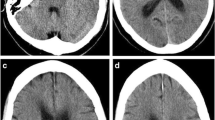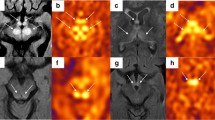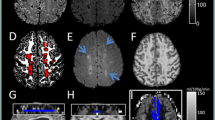Abstract
Introduction
Two types of infarcts can be identified depending on the circumstances leading to its generation-infarcts with pannecrosis and infarcts with selective neuronal loss. Cortical laminar necrosis (CLN) can occur due to various etiologies of which infarctions and hypoxia are the commonest. Infarction results in pannecrosis whereas hypoxia and incomplete infarction result in selective neuronal loss with the presence of viable cells, glial proliferations, and deposition of paramagnetic substances. We investigated patients with CLN with susceptibility-weighted imaging (SWI), a technique highly sensitive to even traces of paramagnetic agents or hemorrhagic components.
Methods
We retrospectively reviewed medical records of patients diagnosed with CLN as per standard criterion. Demographic characteristics and etiologies were recorded. Findings in magnetic resonance images including SWI were analyzed.
Results
We identified 11 patients with CLN, six males and five females with age range of 4–64 years. Etiologies included hypoxia in two patients and infarction in the nine patients. SWI detected diffuse linear hypointensities along the gyral margins in CLN due to hypoxic ischemic encephalopathy. Linear dot like hypointensities were identified in one patient with infarction.
Conclusion
CLN due to hypoxic ischemic encephalopathy display linear gyral hypointensities and basal ganglia hypointensities that are identifiable in SWI and may represent mineralization. This might be related to iron transport across the surviving neurons from basal ganglia to the cortex, which is not possible in complete infarction. SWI may be helpful in understanding the pathophysiological aspects of CLN due to complete infarction and hypoxia.



Similar content being viewed by others
Explore related subjects
Discover the latest articles and news from researchers in related subjects, suggested using machine learning.References
Garcia JH, Lassen NA, Weiller C et al (1996) Ischemic stroke and incomplete infarction. Stroke 27:761–765
Fujioka M, Taoka T, Matsuo Y et al (1999) Novel brain ischemic change on MRI. Delayed ischemic hyperintensity on T1-weighted images and selective neuronal death in the caudoputamen of rats after brief focal ischemia. Stroke 30:1043–1046
Haacke EM, Xu Y, Cheng YC et al (2004) Susceptibility weighted imaging (SWI). Magn Reson Med 52:612–618 doi:10.1002/mrm.20198
Reichenbach JR, Venkatesan R, Schillinger DJ et al (1997) Small vessels in the human brain: MR venography with deoxyhemoglobin as an intrinsic contrast agent. Radiology 204:272–277
Niwa T, Aida N, Shishikura A et al (2008) Susceptibility-weighted imaging findings of cortical laminar necrosis in pediatric patients. AJNR Am J Neuroradiol 29:1795–1798
Siskas N, Lefkopoulos A, Ioannidis I et al (2003) Cortical laminar necrosis in brain infarcts: serial MRI. Neuroradiology 45:283–288
Thomas B, Somasundaram S, Thamburaj K et al (2008) Clinical applications of susceptibility weighted MR imaging of the brain—a pictorial review. Neuroradiology 50:105–116 doi:10.1007/s00234-007-0316-z
Komiyama M, Nakajima H, Nishikawa M et al (1998) Serial MR observation of cortical laminar necrosis caused by brain infarction. Neuroradiology 40:771–777 doi:10.1007/s002340050682
Periakaruppan A, Kesavadas C, Radhakrishnan VV et al (2008) Unique MR spectroscopic finding in colloid-like cyst. Neuroradiology 50:137–144 doi:10.1007/s00234-007-0324-z
Takahashi S, Higano S, Ishii K et al (1993) Hypoxic brain damage: cortical laminar necrosis and delayed changes in white matter at sequential MR imaging. Radiology 189:449–456
Tong KA, Ashwal S, Obenaus A et al (2008) Susceptibility-weighted MR imaging: a review of clinical applications in children. AJNR Am J Neuroradiol 29:9–17 doi:10.3174/ajnr.A0786
Stankiewicz J, Panter SS, Neema M et al (2007) Iron in chronic brain disorders: imaging and neurotherapeutic implications. Neurotherapeutics 4:371–386 doi:10.1016/j.nurt.2007.05.006
Dietrich RB, Bradley WG Jr (1988) Iron accumulation in the basal ganglia following severe ischemic-anoxic insults in children. Radiology 168:203–206
Siesjö B (1992) Pathophysiology and treatment of focal cerebral ischemia. Part I: pathophysiology. J Neurosurg 77:169–184
Fujioka M, Okuchi K, Sakaki T et al (1994) Specific changes in human brain following reperfusion after cardiac arrest. Stroke 25:2091–2095
Conflict of interest statement
We declare that we have no conflict of interest.
Author information
Authors and Affiliations
Corresponding author
Rights and permissions
About this article
Cite this article
Kesavadas, C., Santhosh, K., Thomas, B. et al. Signal changes in cortical laminar necrosis—evidence from susceptibility-weighted magnetic resonance imaging. Neuroradiology 51, 293–298 (2009). https://doi.org/10.1007/s00234-009-0497-8
Received:
Accepted:
Published:
Issue Date:
DOI: https://doi.org/10.1007/s00234-009-0497-8




